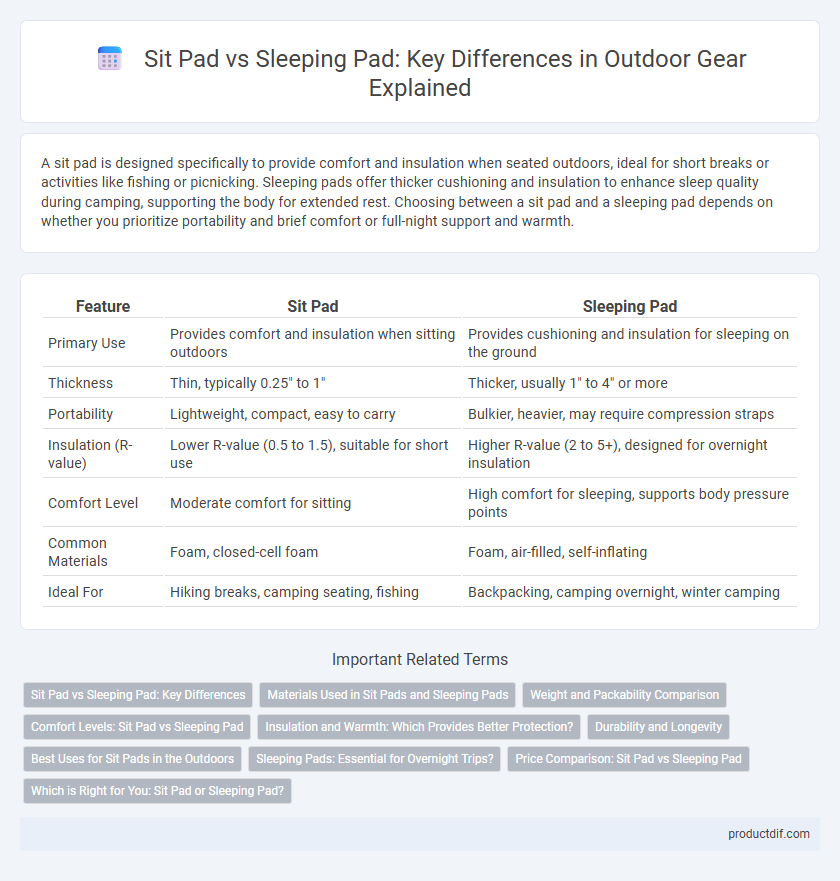A sit pad is designed specifically to provide comfort and insulation when seated outdoors, ideal for short breaks or activities like fishing or picnicking. Sleeping pads offer thicker cushioning and insulation to enhance sleep quality during camping, supporting the body for extended rest. Choosing between a sit pad and a sleeping pad depends on whether you prioritize portability and brief comfort or full-night support and warmth.
Table of Comparison
| Feature | Sit Pad | Sleeping Pad |
|---|---|---|
| Primary Use | Provides comfort and insulation when sitting outdoors | Provides cushioning and insulation for sleeping on the ground |
| Thickness | Thin, typically 0.25" to 1" | Thicker, usually 1" to 4" or more |
| Portability | Lightweight, compact, easy to carry | Bulkier, heavier, may require compression straps |
| Insulation (R-value) | Lower R-value (0.5 to 1.5), suitable for short use | Higher R-value (2 to 5+), designed for overnight insulation |
| Comfort Level | Moderate comfort for sitting | High comfort for sleeping, supports body pressure points |
| Common Materials | Foam, closed-cell foam | Foam, air-filled, self-inflating |
| Ideal For | Hiking breaks, camping seating, fishing | Backpacking, camping overnight, winter camping |
Sit Pad vs Sleeping Pad: Key Differences
Sit pads are lightweight, compact cushions primarily designed to provide insulation and comfort when sitting on cold, hard surfaces during outdoor activities. Sleeping pads are thicker, more insulated mats meant to enhance sleep quality by cushioning and protecting the body from ground moisture and uneven terrain. Key differences include thickness, insulation level, and intended use, with sit pads excelling in portability and sleeping pads prioritizing comfort and thermal protection.
Materials Used in Sit Pads and Sleeping Pads
Sit pads typically use closed-cell foam or EVA foam for lightweight, durable insulation against cold and damp ground. Sleeping pads often incorporate more advanced materials like inflatable TPU or air chambers combined with foam layers to provide enhanced cushioning and thermal insulation. High-quality sleeping pads may also feature reflective coatings such as aluminized surfaces to retain body heat during sleep.
Weight and Packability Comparison
Sit pads are typically lighter and more compact than sleeping pads, making them ideal for short rests and easy to carry in a daypack. Sleeping pads are bulkier and heavier due to their thicker cushioning designed for overnight comfort and insulation. When weight and packability are critical, sit pads offer a minimalist option, while sleeping pads prioritize comfort over portability.
Comfort Levels: Sit Pad vs Sleeping Pad
Sit pads provide essential cushioning and insulation for short-term seating comfort during outdoor activities, using dense foam or inflatable materials to reduce pressure on hard surfaces. Sleeping pads offer a higher level of comfort and support through thicker, often multi-layered designs that enhance spinal alignment and thermal insulation for restful sleep on uneven ground. The choice between sit pads and sleeping pads depends on activity duration and comfort needs, with sleeping pads prioritizing extended rest comfort while sit pads optimize portable seating convenience.
Insulation and Warmth: Which Provides Better Protection?
Sleeping pads offer superior insulation and warmth compared to sit pads, as they are designed to provide a thicker, more insulated barrier between the body and cold ground, often featuring foam or inflatable materials with high R-values. Sit pads prioritize portability and comfort while sitting but typically lack the advanced thermal properties necessary for prolonged heat retention. For outdoor enthusiasts seeking maximum protection against cold surfaces, a sleeping pad with a high R-value is the optimal choice to maintain body heat and prevent heat loss.
Durability and Longevity
Sit pads are designed with rugged materials like closed-cell foam, offering excellent durability against rough terrain and moisture, making them ideal for short-term comfort during breaks. Sleeping pads typically use thicker, more insulated materials such as air or foam with an emphasis on cushioning and thermal protection, which can affect their long-term durability depending on usage and weight carried. Overall, sit pads generally provide longer-lasting wear for frequent, casual use, while sleeping pads require careful maintenance to extend lifespan due to their complex construction.
Best Uses for Sit Pads in the Outdoors
Sit pads excel in providing lightweight, compact cushioning for brief rest breaks, enhancing comfort during hiking, climbing, and outdoor events without adding bulk to your pack. Their primary use is to insulate against cold, damp ground, preventing heat loss and moisture absorption when sitting for short periods. Unlike sleeping pads designed for extended lying down and insulation overnight, sit pads offer quick, portable comfort to preserve energy on the trail.
Sleeping Pads: Essential for Overnight Trips?
Sleeping pads provide crucial insulation and cushioning for overnight trips, improving sleep quality and preventing heat loss from the ground. Unlike sit pads, which primarily offer short-term comfort when seated, sleeping pads are designed to support prolonged rest and enhance overall camping experience. High-R-value sleeping pads ensure warmth in cold conditions, making them essential for multi-night and cold-weather outdoor adventures.
Price Comparison: Sit Pad vs Sleeping Pad
Sit pads are generally more affordable, designed primarily for short-term comfort during breaks or campsite seating, with prices ranging from $10 to $30. Sleeping pads, offering enhanced insulation and cushioning for overnight rest, typically cost between $40 and $150 depending on materials and thickness. The price difference reflects their intended use, durability, and level of comfort, making sit pads a budget-friendly choice for casual outdoor activities while sleeping pads justify higher costs for extended backpacking trips.
Which is Right for You: Sit Pad or Sleeping Pad?
Choosing between a sit pad and a sleeping pad depends on your specific outdoor activity needs and comfort preferences. Sit pads provide lightweight, compact cushioning ideal for short breaks or seating on rough terrain, while sleeping pads offer thicker insulation and support necessary for restful sleep during overnight camping. Evaluating factors like weight, insulation, and intended use will help determine whether a sit pad or sleeping pad best suits your outdoor adventure.
Sit pad vs Sleeping pad Infographic

 productdif.com
productdif.com